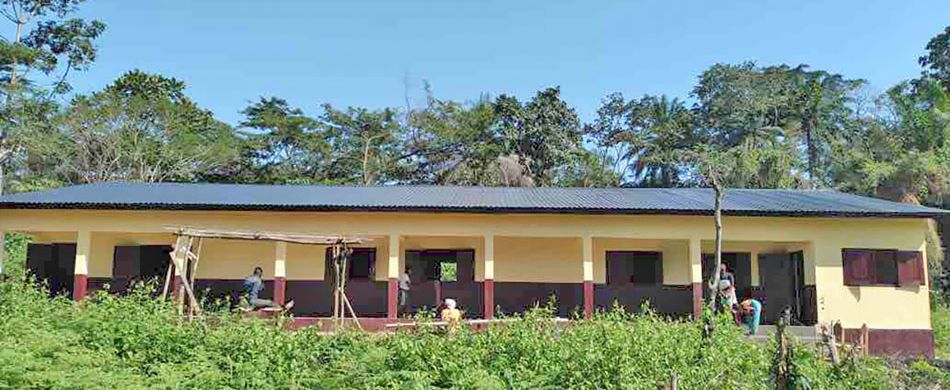A Better School
THE VILLAGE of Aissenezou, high in the mountains of Guinea, some 80 kilometres from the nearest larger town of Macenta, once had no educational facilities. But the young population – 70 percent of which is under the age of 40 – had a thirst for learning and knowledge, and decided to commit to constructing a small classroom building so that their children could be educated in the village.
Very quickly, it became clear that the capacity of the one-room building was insufficient to accommodate all the village children – three students had to share a bench instead of the optimal two. Not only that, after each enrolment of students, the single teacher had to teach them all to the third level of elementary school before starting a new enrolment drive. This resulted in classes often containing pupils ranging from the age of four to nine, and those who enrolled at the age of four being too young to continue primary school in another distant village when they completed studies in the class at the age of seven.
Inadequate building
There were problems with the construction of the building itself, too. “The school was built almost entirely from rammed earth,” explains Father Benoit Kaliva Onivogui. “The walls were no longer straight in places, and there were cracks in several corners of the building. The poor-quality roofing sheets had rusted, and were allowing water to leak into the classroom during rain – which is frequent in Aissenezou. All told, the dilapidation of the building represented a danger to the pupils and the teacher. Something had to be done to alleviate the situation – a new, solidly constructed building was required with two classrooms.
“The nongovernmental organization, Entraide pour le Bien-Etre (mutual aid for well-being) was founded to help rural areas unfairly left to their own devices,” says Father Benoit. “Almost all the villages of the forests in Guinea live in very poor conditions. Agriculture is rudimentary, and the yield is insufficient to meet the needs of the population. Sanitary conditions are poor and the mortality rate of children and pregnant women remains high. Our association tries to find solutions to the multiple problems these villages face.”
€30,000 granted
The project proposed by Entraide pour le Bien-Etre included a larger and more robust building with a foundation made from stone blocks, sand, and cement with pillars of reinforced concrete and chains to provide stability. There would be two classrooms and two offices to provide document storage space, and a room for the school director to receive parents. Each class would be equipped with 20 table-benches – enough for 40 students – and a desk for the teacher. Solar panels would provide the energy required to illuminate the school to allow students to study into the night. On completion, the school would belong to the Aissenezou village community.
The local population agreed to supply stone blocks and sand, and also unskilled manual labour, while the diocese would assist in finding qualified masons and carpenters, and completing paperwork to ensure that all the necessary permits were in place. Entraide pour le Bien Etre would supervise the work and support the village in the permanent management of the school. After taking into account local contributions, the amount requested from and approved by St. Anthony’s Charities was €30,000.
Three instalments
The project started in July 2022, and was finally completed in November 2023. As is often the case with larger projects, payments were made in three instalments. The first phase of the project was the construction of the foundations. The villagers provided all the aggregates needed, and excavated the foundation according to the plans under supervision of qualified builders. The works manager also purchased and arranged the transport of all materials and tools needed for laying the foundation. It was difficult to find a vehicle suitable to transport the materials due to the poor condition of the roads from Macenta. It was also agreed to backfill with red earth, which would compact very firmly and quickly, aided by the heavy rains between July and September.
During the second phase, walls were raised and plastered, paving was laid and finally the roof was put in place after the walls had had time to dry out properly. During this phase, heavy rain continued, and this made it difficult to maintain a steady supply of bricks, which consequently delayed the construction activities. The road conditions also worsened as a result of the rains.
The final work phase commenced in July 2023. This included painting, installing doors and windows, and constructing table-benches for the pupils, and desks and chairs for the teachers. Due to the rise in prices of some materials and the continued difficulties transporting materials to the village, work was delayed. These delays were exacerbated by family crises and other personal matters, which resulted in some of the workers not respecting the work schedule. But despite the delays, work was finally completed in November 2023.
God bless you
The completed school has capacity for 80 pupils, and now has two teachers and can cover education up to the 5th primary class, after which the pupils can continue their education in other schools. The village of Aissenezou will continue to support the new school as they did the single classroom. Every year, each family gives a contribution of 50kg of rice and 40 litres of oil. Additionally, registration fees contribute to the cost of teaching materials. Whereas previously the village also paid for the teacher, the Guinean State will cover the salaries for the two teachers.
“The end of the works were greeted with great joy by the population of Aissenezou,” concludes Fr. Benoit. “We thank St. Anthony’s Charities, the readers of the Messenger of Saint Anthony, and all our benefactors. God bless you all.”



